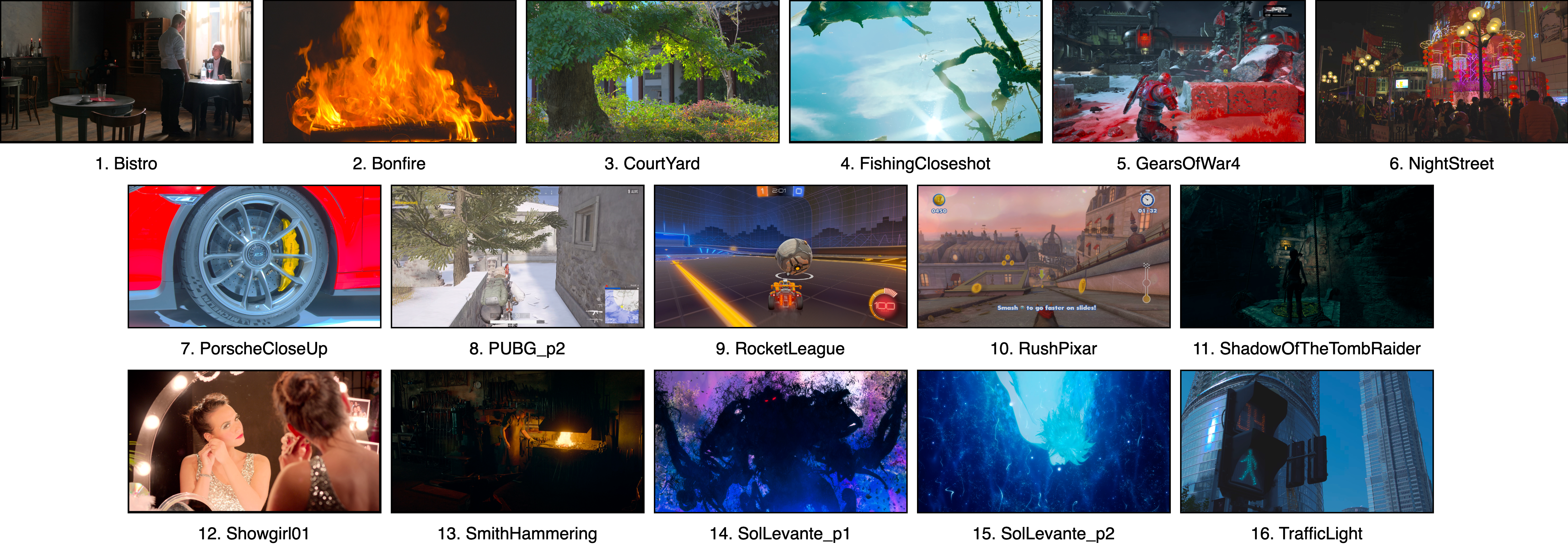Projects
The effect of viewing distance and display peak luminance — HDR AV1 video streaming quality dataset
Dounia Hammou(1), Lukáš Krasula(2), Christos G. Bampis(2), Zhi Li(2), Rafał K. Mantiuk(1)
(1)University of Cambridge, (2)Netflix, Inc.
Presented at QoMEX 2024
In this dataset, we measure the visibility of distortions due to streaming across viewing distances and display peak luminance levels. The figure showcases the experimental setup for the near-near viewing setting and bright display luminance session.

The effect of viewing distance and display peak luminance on the perception of quality for different resolutions and bitrates. The figure reveals a consistent pattern, wherein observers are less likely to notice the drop of quality at lower bitrates or lower resolution when the video is shown from a further distance or at a lower luminance level.
Abstract
While it is well recognized that the visibility of distortions is affected by the viewing distance and display peak luminance, very few datasets control those conditions, and also few video quality metrics can account for them. To address this gap, we collected a new video quality dataset, HDR-VDC, which captures the quality degradation of HDR content due to AV1 coding artifacts and the resolution reduction. The quality drop was measured at two viewing distances, corresponding to 60 and 120 pixels per visual degree, and two display mean luminance levels, 51 and 5.6 nits. In contrast to the existing datasets that use direct rating protocol, we employ a highly sensitive pairwise comparison protocol with active sampling and comparisons across viewing distances to ensure possibly accurate quality measurements. We also provide the first publicly available dataset that measures the effect of display peak luminance and includes HDR videos encoded with AV1. Our results indicate t hat the effect of both viewing distance and display luminance is significant, and it reduces the visibility of coding and upsampling artifacts on dimmer displays or those seen from a further distance.
Materials
- Paper:
The effect of viewing distance and display peak luminance — HDR AV1 video streaming quality dataset
Dounia Hammou, Lukáš Krasula, Christos G. Bampis, Zhi Li, and Rafał K. Mantiuk.
In: 2024 16th International Conference on Quality of Multimedia Experience (QoMEX), IEEE 2024.
[Paper - PDF] - Code: [Github]
- Dataset: [Dataset Repository]
Dataset Key Information
| Conditions (Reference) |
Distortions | AV1 Distortions |
Resolutions | Viewing Distances [m] |
Display Size [in] / Field Size [°] |
Effective Resolution [ppd] |
Display Peak Luminance Levels [nits] |
|
|---|---|---|---|---|---|---|---|---|
| 132 (16) | AV1 Encoding Lanczos (a=3) Upscaling |
3 compression levels (3 CRF values) |
3840x2160 1920x1080 1280x720 |
1.1 | 55 / | 58° x 35° | 62 | 800 |
| 2.2 | 31° x 18° | 122 | 100 | |||||
Reference Videos Screenshot

Image Gallery
The images showcase the experimental setup at different viewing settings. The images are taken at different sessions from the experiment (the bright ambient illumination is for visibility purposes).
Video Gallery
The videos showcase the experimental procedure at a near-near viewing setting.
Related projects
- A practical guide and software for analysing pairwise comparison experiments
- ASAP: Active Sampling for Pairwise Comparisons
- Image quality assessment across viewing distances: A comparison study of CSF-based and rescaling-based metrics
- Comparison of metrics for predicting image and video quality at varying viewing distances
Acknowledgement
We thank Mario Kleiner for his help in running the experiment in real time using the Psychtoolbox-3 framework. Additionally, we thank Maliha Ashraf and Joseph G. March for their insightful comments and advice throughout the project. Finally, we thank all participants of the experiment for their valuable time.
This work was supported by the Netflix Studentship to Dounia Hammou.
